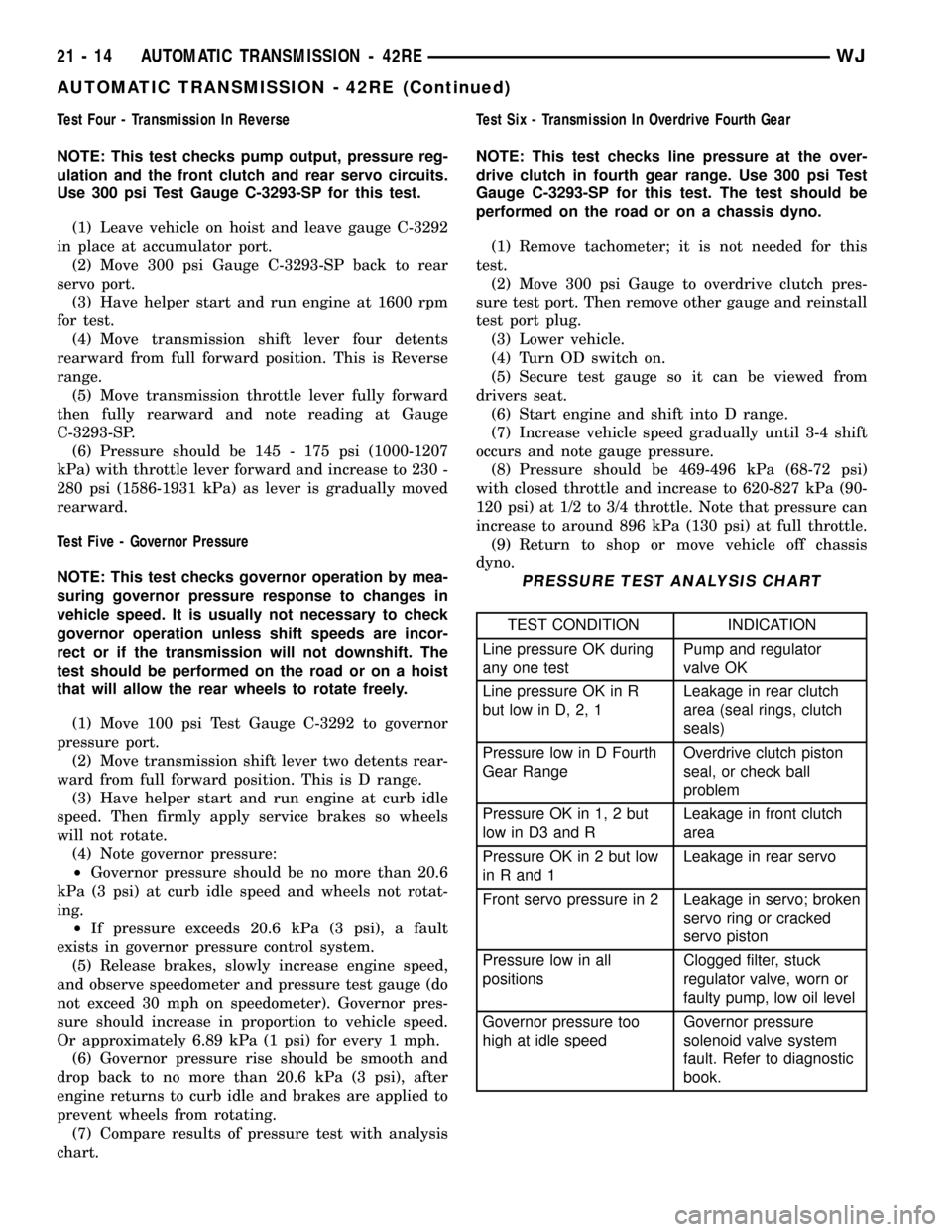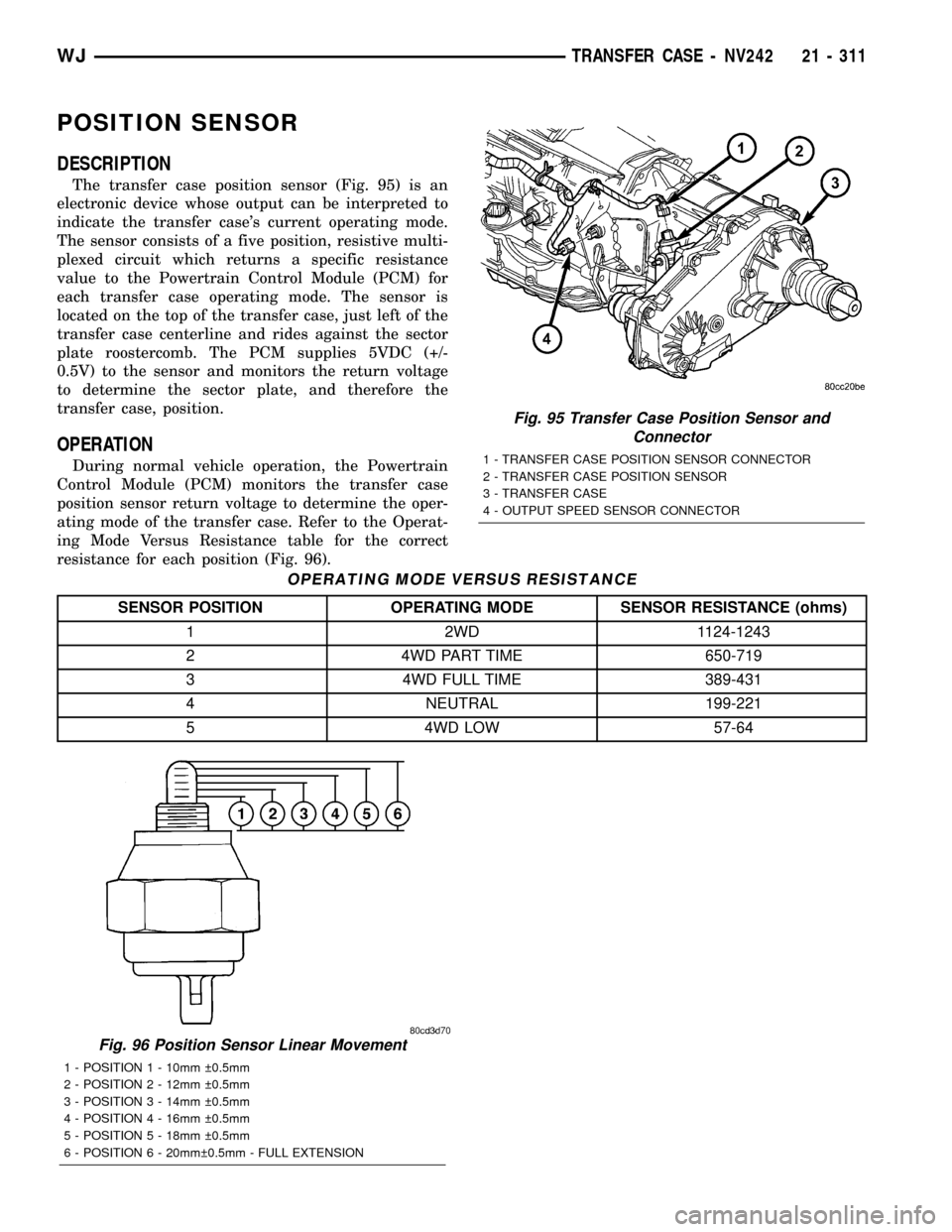2003 JEEP GRAND CHEROKEE 8w -12 -1
[x] Cancel search: 8w -12 -1Page 1040 of 2199

8W-70 SPLICE INFORMATION
Component PageS100.............................8W-10-11, 12
S102.............................8W-30-21, 45
S104................................8W-15-4
S105...............................8W-30-20
S106.............................8W-10-19, 20
S107............................8W-70-2, 3, 4, 5
S109...............................8W-10-21
S110 ................................8W-70-2
S111................................8W-10-23
S112............................8W-70-2, 3, 4, 5
S113................................8W-31-13
S114 ................................8W-15-2
S115................................8W-10-17
S116................................8W-12-18
S118................................8W-10-22
S119 ..............................8W-31-9, 10
S120...............................8W-30-20
S121...............................8W-10-21
S122...............................8W-31-5, 6
S123.............................8W-10-19, 20
S123...............................8W-30-12
S124...............................8W-10-22
S125................................8W-30-6
S126...............................8W-30-23
S127...............................8W-10-27
S128.............................8W-10-19, 20
S130...............................8W-18-3, 5
S131...............................8W-70-6, 7
S132............................8W-15-9, 10, 11
S133............................8W-15-9, 10, 11
S134...............................8W-15-6, 7
S135...............................8W-10-18
S136...............................8W-10-18
S137...............................8W-10-31
S139................................8W-15-3
S140................................8W-15-7
S141................................8W-15-6
S142..............................8W-12-3, 32
S143..............................8W-12-5, 32
S145................................8W-70-6
S147...............................8W-30-51
S151................................8W-15-5
S152................................8W-15-8
S153...............................8W-12-14
S154...............................8W-12-33
S155...............................8W-12-33
S156...............................8W-12-14
S158................................8W-70-5
S160................................8W-30-11
S162...............................8W-10-26
S163..............................8W-12-7, 15
S165................................8W-51-9
S168...............................8W-10-26
S169...............................8W-30-47
S170...............................8W-30-44
S171...............................8W-30-36
S172...............................8W-30-36
S174................................8W-15-6
S175................................8W-21-2
S176...............................8W-10-26
S200...............................8W-63-12
S201...............................8W-15-15
S202...............................8W-44-10
S203...............................8W-15-14
S204...............................8W-12-22
S205...............................8W-15-15
S206...............................8W-12-22
S207...............................8W-12-16
S208................................8W-44-8
S209................................8W-12-11
S210...............................8W-18-4, 7
S211................................8W-15-13
S212................................8W-53-2
S213................................8W-33-5
S214................................8W-33-5
S215...............................8W-47-13
S216...............................8W-47-13
S217...............................8W-18-10Component PageS221................................8W-12-11
S222...............................8W-30-37
S223............................8W-18-8, 9, 10
S224.............................8W-15-17, 18
S300...............................8W-15-21
S301...............................8W-15-21
S302...............................8W-61-5, 6
S303...............................8W-61-5, 6
S304...............................8W-12-16
S305...............................8W-18-2, 6
S306...............................8W-12-27
S307...............................8W-15-19
S308...............................8W-12-36
S309...............................8W-12-12
S310...............................8W-51-7, 8
S311 ................................8W-51-5
S312...............................8W-18-2, 6
S313...............................8W-51-5, 6
S314................................8W-33-2
S315...............................8W-70-6, 7
S316...............................8W-12-18
S317................................8W-61-5
S318................................8W-61-5
S319...............................8W-12-21
S323................................8W-18-9
S324...............................8W-18-3, 5
S326.............................8W-12-12, 13
S327...............................8W-12-32
S328................................8W-51-7
S329...............................8W-15-17
S330...............................8W-15-16
S331.............................8W-15-17, 18
S332.............................8W-15-17, 18
S333................................8W-47-3
S334................................8W-12-11
S336...............................8W-15-16
S337...............................8W-12-25
S338...............................8W-15-16
S339...............................8W-61-5, 6
S340...............................8W-61-5, 6
S341.............................8W-15-17, 22
S342................................8W-12-9
S345...............................8W-15-19
S346...............................8W-12-16
S347...............................8W-12-30
S348...............................8W-12-24
S349...............................8W-12-23
S351................................8W-70-8
S352................................8W-63-8
S353................................8W-12-9
S355.............................8W-15-18, 21
S356.............................8W-15-21, 22
S357.............................8W-15-16, 18
S358...............................8W-15-22
S359................................8W-50-9
S360................................8W-47-4
S361................................8W-47-4
S362................................8W-47-4
S363................................8W-47-4
S364................................8W-18-5
S365................................8W-39-11
S366...............................8W-12-15
S367...............................8W-12-36
S368................................8W-47-3
S369.............................8W-15-21, 22
S370...............................8W-15-19
S400...............................8W-12-17
S401...............................8W-15-20
S402...............................8W-15-20
S403...............................8W-12-16
S404...............................8W-12-30
S405...............................8W-12-30
S406................................8W-54-6
S407................................8W-54-6
S408...............................8W-15-19
S410...............................8W-15-19
S411 .............................8W-12-12, 13
S412...............................8W-15-20
WJ8W-70 SPLICE INFORMATION 8W - 70 - 1
Page 1048 of 2199

8W-80 CONNECTOR PIN-OUT
Component Page
A/C COMPRESSOR CLUTCH.......... 8W-80-6
A/C PRESSURE TRANSDUCER........ 8W-80-6
ACCELERATOR PEDAL POSITION
SENSOR (DIESEL)................. 8W-80-6
ADJUSTABLE PEDALS MODULE
(EXCEPT BUILT-UP-EXPORT)....... 8W-80-6
ADJUSTABLE PEDALS MOTOR/SENSOR
ASSEMBLY (EXCEPT
BUILT-UP-EXPORT)............... 8W-80-7
ADJUSTABLE PEDALS SWITCH (EXCEPT
BUILT-UP-EXPORT)............... 8W-80-7
AIRBAG CONTROL MODULE C1
(ORC C1)........................ 8W-80-7
AIRBAG CONTROL MODULE C2
(ORC C2)........................ 8W-80-8
AMBIENT TEMPERATURE SENSOR.... 8W-80-8
ANTENNA MODULE
(BUILT-UP-EXPORT)............... 8W-80-8
ASH RECEIVER LAMP............... 8W-80-9
AUTOMATIC DAY/NIGHT MIRROR..... 8W-80-9
AUTOMATIC HEADLAMP LIGHT
SENSOR/VTSS LED................ 8W-80-9
AUTOMATIC ZONE CONTROL
MODULE C1 (AZC)................ 8W-80-9
AUTOMATIC ZONE CONTROL
MODULE C2 (AZC)............... 8W-80-10
BATTERY TEMPERATURE SENSOR . . . 8W-80-10
BLOWER MOTOR.................. 8W-80-10
BLOWER MOTOR CONTROLLER
(AZC).......................... 8W-80-10
BLOWER MOTOR RESISTOR
BLOCK (MTC)................... 8W-80-10
BODY CONTROL MODULE C1........ 8W-80-11
BODY CONTROL MODULE C2........ 8W-80-11
BOOST PRESSURE SENSOR
(DIESEL)....................... 8W-80-12
BRAKE LAMP SWITCH.............. 8W-80-12
C100............................. 8W-80-12
C100............................. 8W-80-12
C101 (4.0L RHD)................... 8W-80-12
C101 (4.0L RHD)................... 8W-80-13
C101 (4.7L RHD)................... 8W-80-13
C101 (4.7L RHD)................... 8W-80-13
C102 (DIESEL)..................... 8W-80-14
C102 (DIESEL)..................... 8W-80-14
C102 (GAS RHD)................... 8W-80-14
C102 (GAS RHD)................... 8W-80-15
C103 (DIESEL)..................... 8W-80-15
C103 (DIESEL)..................... 8W-80-15
C103 (GAS)........................ 8W-80-16
C103 (GAS)........................ 8W-80-16
C104............................. 8W-80-17
C104............................. 8W-80-17Component Page
C105 (DIESEL)..................... 8W-80-17
C105 (DIESEL)..................... 8W-80-18
C106 (DIESEL)..................... 8W-80-18
C106 (DIESEL)..................... 8W-80-20
C106 (GAS)........................ 8W-80-22
C106 (GAS)........................ 8W-80-24
C107 (DIESEL)..................... 8W-80-26
C107 (DIESEL)..................... 8W-80-28
C107 (GAS)........................ 8W-80-30
C107 (GAS)........................ 8W-80-32
C108............................. 8W-80-33
C108............................. 8W-80-33
C109............................. 8W-80-33
C109............................. 8W-80-34
C110 (DIESEL)..................... 8W-80-34
C110 (DIESEL)..................... 8W-80-34
C111 ............................. 8W-80-34
C111 ............................. 8W-80-34
C112 ............................. 8W-80-35
C112 ............................. 8W-80-35
C113 (DIESEL)..................... 8W-80-35
C113 (DIESEL)..................... 8W-80-35
C200............................. 8W-80-36
C200............................. 8W-80-38
C201 (DIESEL)..................... 8W-80-39
C201 (DIESEL)..................... 8W-80-39
C202 (AZC)........................ 8W-80-40
C202 (AZC)........................ 8W-80-40
C202 (MTC)....................... 8W-80-41
C202 (MTC)....................... 8W-80-41
C203 (AZC)........................ 8W-80-41
C203 (AZC)........................ 8W-80-41
C300 (LHD)........................ 8W-80-42
C300 (LHD)........................ 8W-80-44
C301 (RHD)....................... 8W-80-46
C301 (RHD)....................... 8W-80-48
C302............................. 8W-80-49
C302............................. 8W-80-50
C303............................. 8W-80-50
C303............................. 8W-80-51
C304............................. 8W-80-51
C304............................. 8W-80-51
C306............................. 8W-80-52
C306............................. 8W-80-52
C307............................. 8W-80-52
C307............................. 8W-80-52
C308............................. 8W-80-53
C308............................. 8W-80-53
C309............................. 8W-80-53
C309............................. 8W-80-54
C310 (BUILT-UP-EXPORT)........... 8W-80-54
C310 (BUILT-UP-EXPORT)........... 8W-80-54
WJ8W-80 CONNECTOR PIN-OUT 8W - 80 - 1
Page 1052 of 2199

Component Page
RIGHT FRONT WHEEL SPEED
SENSOR....................... 8W-80-115
RIGHT HEADLAMP LEVELING MOTOR
(BUILT-UP-EXPORT)............. 8W-80-115
RIGHT HIGH BEAM HEADLAMP..... 8W-80-116
RIGHT INSTRUMENT PANEL
SPEAKER...................... 8W-80-116
RIGHT LIFTGATE AJAR SWITCH..... 8W-80-116
RIGHT LOW BEAM HEADLAMP..... 8W-80-116
RIGHT MULTI-FUNCTION SWITCH . . . 8W-80-116
RIGHT REAR DOOR LOCK
MOTOR/AJAR SWITCH........... 8W-80-117
RIGHT REAR DOOR SPEAKER....... 8W-80-117
RIGHT REAR LAMP ASSEMBLY...... 8W-80-117
RIGHT REAR WHEEL SPEED
SENSOR....................... 8W-80-117
RIGHT REMOTE RADIO SWITCH.... 8W-80-117
RIGHT SIDE REPEATER LAMP
(BUILT-UP-EXPORT)............. 8W-80-118
RIGHT VISOR/VANITY LAMP........ 8W-80-118
SEAT BELT SWITCH............... 8W-80-118
SEAT MODULE C1 (PREMIUM)...... 8W-80-118
SEAT MODULE C2 (PREMIUM)...... 8W-80-119
SENTRY KEY IMMOBILIZER
MODULE...................... 8W-80-119
SHIFTER ASSEMBLY
(C201 DIESEL).................. 8W-80-119
SHIFTER ASSEMBLY (GAS)......... 8W-80-120
SHIFTER ASSEMBLY C1 (DIESEL).... 8W-80-120
SHIFTER ASSEMBLY C2 (DIESEL).... 8W-80-120
SIREN (BUILT-UP-EXPORT)......... 8W-80-120
SPEED CONTROL SWITCH NO. 1.... 8W-80-120
SPEED CONTROL SWITCH NO. 2.... 8W-80-121
SUNROOF CONTROL MODULE...... 8W-80-121
SUNROOF MOTOR C1.............. 8W-80-121
SUNROOF MOTOR C2.............. 8W-80-121
SUNROOF SWITCH................ 8W-80-121Component Page
TEMPERATURE VALVE
ACTUATOR (MTC)............... 8W-80-122
THROTTLE POSITION
SENSOR (4.0L).................. 8W-80-122
THROTTLE POSITION
SENSOR (4.7L).................. 8W-80-122
TRAILER TOW BRAKE
LAMP RELAY................... 8W-80-122
TRAILER TOW CIRCUIT
BREAKER...................... 8W-80-122
TRAILER TOW CONNECTOR........ 8W-80-123
TRAILER TOW LEFT TURN
RELAY........................ 8W-80-123
TRAILER TOW RIGHT TURN
RELAY........................ 8W-80-123
TRANSFER CASE POSITION
SENSOR....................... 8W-80-123
TRANSMISSION CONTROL
MODULE (4.7L)................. 8W-80-124
TRANSMISSION CONTROL
MODULE C1 (DIESEL)........... 8W-80-125
TRANSMISSION CONTROL
MODULE C2 (DIESEL)........... 8W-80-125
TRANSMISSION SOLENOID (4.0L).... 8W-80-125
TRANSMISSION SOLENOID
ASSEMBLY (DIESEL)............ 8W-80-126
TRANSMISSION SOLENOID/TRS
ASSEMBLY (4.7L)................ 8W-80-126
UNDERHOOD LAMP............... 8W-80-126
VEHICLE INFORMATION CENTER . . . 8W-80-127
VISCOUS/CABIN HEATER
(DIESEL)...................... 8W-80-127
WASHER FLUID LEVEL SWITCH.... 8W-80-127
WASTEGATE SOLENOID
(DIESEL)...................... 8W-80-127
WATER IN FUEL SENSOR
(DIESEL)...................... 8W-80-127
WJ8W-80 CONNECTOR PIN-OUT 8W - 80 - 5
Page 1533 of 2199

Test Four - Transmission In Reverse
NOTE: This test checks pump output, pressure reg-
ulation and the front clutch and rear servo circuits.
Use 300 psi Test Gauge C-3293-SP for this test.
(1) Leave vehicle on hoist and leave gauge C-3292
in place at accumulator port.
(2) Move 300 psi Gauge C-3293-SP back to rear
servo port.
(3) Have helper start and run engine at 1600 rpm
for test.
(4) Move transmission shift lever four detents
rearward from full forward position. This is Reverse
range.
(5) Move transmission throttle lever fully forward
then fully rearward and note reading at Gauge
C-3293-SP.
(6) Pressure should be 145 - 175 psi (1000-1207
kPa) with throttle lever forward and increase to 230 -
280 psi (1586-1931 kPa) as lever is gradually moved
rearward.
Test Five - Governor Pressure
NOTE: This test checks governor operation by mea-
suring governor pressure response to changes in
vehicle speed. It is usually not necessary to check
governor operation unless shift speeds are incor-
rect or if the transmission will not downshift. The
test should be performed on the road or on a hoist
that will allow the rear wheels to rotate freely.
(1) Move 100 psi Test Gauge C-3292 to governor
pressure port.
(2) Move transmission shift lever two detents rear-
ward from full forward position. This is D range.
(3) Have helper start and run engine at curb idle
speed. Then firmly apply service brakes so wheels
will not rotate.
(4) Note governor pressure:
²Governor pressure should be no more than 20.6
kPa (3 psi) at curb idle speed and wheels not rotat-
ing.
²If pressure exceeds 20.6 kPa (3 psi), a fault
exists in governor pressure control system.
(5) Release brakes, slowly increase engine speed,
and observe speedometer and pressure test gauge (do
not exceed 30 mph on speedometer). Governor pres-
sure should increase in proportion to vehicle speed.
Or approximately 6.89 kPa (1 psi) for every 1 mph.
(6) Governor pressure rise should be smooth and
drop back to no more than 20.6 kPa (3 psi), after
engine returns to curb idle and brakes are applied to
prevent wheels from rotating.
(7) Compare results of pressure test with analysis
chart.Test Six - Transmission In Overdrive Fourth Gear
NOTE: This test checks line pressure at the over-
drive clutch in fourth gear range. Use 300 psi Test
Gauge C-3293-SP for this test. The test should be
performed on the road or on a chassis dyno.
(1) Remove tachometer; it is not needed for this
test.
(2) Move 300 psi Gauge to overdrive clutch pres-
sure test port. Then remove other gauge and reinstall
test port plug.
(3) Lower vehicle.
(4) Turn OD switch on.
(5) Secure test gauge so it can be viewed from
drivers seat.
(6) Start engine and shift into D range.
(7) Increase vehicle speed gradually until 3-4 shift
occurs and note gauge pressure.
(8) Pressure should be 469-496 kPa (68-72 psi)
with closed throttle and increase to 620-827 kPa (90-
120 psi) at 1/2 to 3/4 throttle. Note that pressure can
increase to around 896 kPa (130 psi) at full throttle.
(9) Return to shop or move vehicle off chassis
dyno.
PRESSURE TEST ANALYSIS CHART
TEST CONDITION INDICATION
Line pressure OK during
any one testPump and regulator
valve OK
Line pressure OK in R
but low in D, 2, 1Leakage in rear clutch
area (seal rings, clutch
seals)
Pressure low in D Fourth
Gear RangeOverdrive clutch piston
seal, or check ball
problem
Pressure OK in 1, 2 but
low in D3 and RLeakage in front clutch
area
Pressure OK in 2 but low
in R and 1Leakage in rear servo
Front servo pressure in 2 Leakage in servo; broken
servo ring or cracked
servo piston
Pressure low in all
positionsClogged filter, stuck
regulator valve, worn or
faulty pump, low oil level
Governor pressure too
high at idle speedGovernor pressure
solenoid valve system
fault. Refer to diagnostic
book.
21 - 14 AUTOMATIC TRANSMISSION - 42REWJ
AUTOMATIC TRANSMISSION - 42RE (Continued)
Page 1830 of 2199

POSITION SENSOR
DESCRIPTION
The transfer case position sensor (Fig. 95) is an
electronic device whose output can be interpreted to
indicate the transfer case's current operating mode.
The sensor consists of a five position, resistive multi-
plexed circuit which returns a specific resistance
value to the Powertrain Control Module (PCM) for
each transfer case operating mode. The sensor is
located on the top of the transfer case, just left of the
transfer case centerline and rides against the sector
plate roostercomb. The PCM supplies 5VDC (+/-
0.5V) to the sensor and monitors the return voltage
to determine the sector plate, and therefore the
transfer case, position.
OPERATION
During normal vehicle operation, the Powertrain
Control Module (PCM) monitors the transfer case
position sensor return voltage to determine the oper-
ating mode of the transfer case. Refer to the Operat-
ing Mode Versus Resistance table for the correct
resistance for each position (Fig. 96).
OPERATING MODE VERSUS RESISTANCE
SENSOR POSITION OPERATING MODE SENSOR RESISTANCE (ohms)
1 2WD 1124-1243
2 4WD PART TIME 650-719
3 4WD FULL TIME 389-431
4 NEUTRAL 199-221
5 4WD LOW 57-64
Fig. 96 Position Sensor Linear Movement
1 - POSITION 1 - 10mm 0.5mm
2 - POSITION 2 - 12mm 0.5mm
3 - POSITION 3 - 14mm 0.5mm
4 - POSITION 4 - 16mm 0.5mm
5 - POSITION 5 - 18mm 0.5mm
6 - POSITION 6 - 20mm 0.5mm - FULL EXTENSION
Fig. 95 Transfer Case Position Sensor and
Connector
1 - TRANSFER CASE POSITION SENSOR CONNECTOR
2 - TRANSFER CASE POSITION SENSOR
3 - TRANSFER CASE
4 - OUTPUT SPEED SENSOR CONNECTOR
WJTRANSFER CASE - NV242 21 - 311
Page 2078 of 2199

HEATING & AIR CONDITIONING
TABLE OF CONTENTS
page page
HEATING & AIR CONDITIONING
DESCRIPTION
DESCRIPTION - COOLING SYSTEM
REQUIREMENTS.......................1
DESCRIPTION - HEATER AND AIR
CONDITIONER........................1
DESCRIPTION - REFRIGERANT SYSTEM
SERVICE PORT........................1
OPERATION
OPERATION - HEATER AND AIR
CONDITIONER........................2
OPERATION - REFRIGERANT SYSTEM
SERVICE PORT........................2DIAGNOSIS AND TESTING
DIAGNOSIS AND TESTING - A/C
PERFORMANCE.......................2
DIAGNOSIS AND TESTING - HEATER
PERFORMANCE.......................6
STANDARD PROCEDURE - DIODE
REPLACEMENT.......................6
SPECIFICATIONS
A/C APPLICATION TABLE................7
TORQUE SPECIFICATIONS..............8
CONTROLS.............................9
DISTRIBUTION..........................36
PLUMBING.............................51
HEATING & AIR
CONDITIONING
DESCRIPTION
DESCRIPTION - COOLING SYSTEM
REQUIREMENTS
To maintain the performance level of the heating-
air conditioning system, the engine cooling system
must be properly maintained. The use of a bug
screen is not recommended. Any obstructions in front
of the radiator or condenser will reduce the perfor-
mance of the air conditioning and engine cooling sys-
tems.
The engine cooling system includes the heater core
and the heater hoses. Refer to Cooling for more infor-
mation before opening, or attempting any service to
the engine cooling system.
DESCRIPTION - HEATER AND AIR
CONDITIONER
A manual temperature control type heating-air
conditioning system is standard factory-installed
equipment on this model. An electronically controlled
Automatic Zone Control (AZC) type heating-air con-
ditioning system is an available factory-installed
option.
All vehicles are equipped with a common HVAC
housing assembly (Fig. 1). The system combines air
conditioning, heating, and ventilating capabilities in
a single unit housing mounted under the instrument
panel.DESCRIPTION - REFRIGERANT SYSTEM
SERVICE PORT
The two refrigerant system service ports are used
to charge, recover/recycle, evacuate, and test the air
conditioning refrigerant system. Unique service port
coupler sizes are used on the R-134a system to
ensure that the refrigerant system is not accidentally
contaminated by the use of the wrong refrigerant
(R-12), or refrigerant system service equipment.
Fig. 1 Blend-Air HVAC System - (typical)
1 - Blend Door
2 - Expansion Valve
3 - Evaporator Core
4 - Blower Assembly
5 - Recirculation Door
6 - Evaporator Probe
7 - Heater Core
8 - Heat/Defrost Door
9 - Panel/Defrost Door
WJHEATING & AIR CONDITIONING 24 - 1
Page 2129 of 2199

VISCOUS HEATER
DESCRIPTION
DESCRIPTION........................76
DESCRIPTION - VISCOUS HEATER
CLUTCH............................76
OPERATION
OPERATION - VISCOUS HEATER.........76
OPERATION - VISCOUS HEATER CLUTCH . . 76REMOVAL
REMOVAL - VISCOUS HEATER...........76
REMOVAL - VISCOUS HEATER CLUTCH . . . 76
INSTALLATION
INSTALLATION.......................78
INSTALLATION - VISCOUS HEATER
CLUTCH............................78
PLUMBING
DESCRIPTION - REFRIGERANT LINE
The refrigerant lines and hoses are used to carry
the refrigerant between the various air conditioning
system components. A barrier hose design with a
nylon tube, which is sandwiched between rubber lay-
ers, is used for the R-134a air conditioning system on
this vehicle. This nylon tube helps to further contain
the R-134a refrigerant, which has a smaller molecu-
lar structure than R-12 refrigerant. The ends of the
refrigerant hoses are made from lightweight alumi-
num or steel, and commonly use braze-less fittings.
Any kinks or sharp bends in the refrigerant plumb-
ing will reduce the capacity of the entire air condi-
tioning system. Kinks and sharp bends reduce the
flow of refrigerant in the system. A good rule for the
flexible hose refrigerant lines is to keep the radius of
all bends at least ten times the diameter of the hose.
In addition, the flexible hose refrigerant lines should
be routed so they are at least 80 millimeters (3
inches) from the exhaust manifold.
OPERATION - REFRIGERANT LINE
High pressures are produced in the refrigerant sys-
tem when the air conditioning compressor is operat-
ing. Extreme care must be exercised to make sure
that each of the refrigerant system connections is
pressure-tight and leak free. It is a good practice to
inspect all flexible hose refrigerant lines at least once
a year to make sure they are in good condition and
properly routed.
The refrigerant lines and hoses cannot be repaired
and, if faulty or damaged, they must be replaced.
WARNING
WARNING: THE AIR CONDITIONING SYSTEM CON-
TAINS REFRIGERANT UNDER HIGH PRESSURE.
SEVERE PERSONAL INJURY MAY RESULT FROM
IMPROPER SERVICE PROCEDURES. REPAIRS
SHOULD ONLY BE PERFORMED BY QUALIFIED
SERVICE PERSONNEL.
AVOID BREATHING THE REFRIGERANT AND
REFRIGERANT OIL VAPOR OR MIST. EXPOSURE
MAY IRRITATE THE EYES, NOSE, AND/OR THROAT.
WEAR EYE PROTECTION WHEN SERVICING THE
AIR CONDITIONING REFRIGERANT SYSTEM. SERI-
OUS EYE INJURY CAN RESULT FROM DIRECT
CONTACT WITH THE REFRIGERANT. IF EYE CON-
TACT OCCURS, SEEK MEDICAL ATTENTION IMME-
DIATELY.
DO NOT EXPOSE THE REFRIGERANT TO OPEN
FLAME. POISONOUS GAS IS CREATED WHEN
REFRIGERANT IS BURNED. AN ELECTRONIC LEAK
DETECTOR IS RECOMMENDED.
IF ACCIDENTAL SYSTEM DISCHARGE OCCURS,
VENTILATE THE WORK AREA BEFORE RESUMING
SERVICE. LARGE AMOUNTS OF REFRIGERANT
RELEASED IN A CLOSED WORK AREA WILL DIS-
PLACE THE OXYGEN AND CAUSE SUFFOCATION.
THE EVAPORATION RATE OF R-134a REFRIGER-
ANT AT AVERAGE TEMPERATURE AND ALTITUDE
IS EXTREMELY HIGH. AS A RESULT, ANYTHING
THAT COMES IN CONTACT WITH THE REFRIGER-
ANT WILL FREEZE. ALWAYS PROTECT THE SKIN
OR DELICATE OBJECTS FROM DIRECT CONTACT
WITH THE REFRIGERANT.
THE R-134a SERVICE EQUIPMENT OR THE VEHI-
CLE REFRIGERANT SYSTEM SHOULD NOT BE
PRESSURE TESTED OR LEAK TESTED WITH COM-
PRESSED AIR. SOME MIXTURES OF AIR AND
R-134a HAVE BEEN SHOWN TO BE COMBUSTIBLE
AT ELEVATED PRESSURES. THESE MIXTURES ARE
POTENTIALLY DANGEROUS, AND MAY RESULT IN
FIRE OR EXPLOSION CAUSING INJURY OR PROP-
ERTY DAMAGE.
24 - 52 PLUMBINGWJ
Page 2130 of 2199

CAUTION
CAUTION
CAUTION: Liquid refrigerant is corrosive to metal
surfaces. Follow the operating instructions supplied
with the service equipment being used.
Never add R-12 to a refrigerant system designed to
use R-134a. Damage to the system will result.
R-12 refrigerant oil must not be mixed with R-134a
refrigerant oil. They are not compatible.
Do not use R-12 equipment or parts on the R-134a
system. Damage to the system will result.
Do not overcharge the refrigerant system. This will
cause excessive compressor head pressure and
can cause noise and system failure.
Recover the refrigerant before opening any fitting
or connection. Open the fittings with caution, even
after the system has been discharged. Never open
or loosen a connection before recovering the refrig-
erant.
The refrigerant system must always be evacuated
before charging.
Do not open the refrigerant system or uncap a
replacement component until you are ready to ser-
vice the system. This will prevent contamination in
the system.
Before disconnecting a component, clean the out-
side of the fittings thoroughly to prevent contami-
nation from entering the refrigerant system.
Immediately after disconnecting a component from
the refrigerant system, seal the open fittings with a
cap or plug.
Before connecting an open refrigerant fitting,
always install a new seal or gasket. Coat the fitting
and seal with clean refrigerant oil before connect-
ing.
Do not remove the sealing caps from a replacement
component until it is to be installed.
When installing a refrigerant line, avoid sharp
bends that may restrict refrigerant flow. Position the
refrigerant lines away from exhaust system compo-
nents or any sharp edges, which may damage the
line.
Tighten refrigerant fittings only to the specified
torque. The aluminum fittings used in the refriger-
ant system will not tolerate overtightening.
When disconnecting a refrigerant fitting, use a
wrench on both halves of the fitting. This will pre-
vent twisting of the refrigerant lines or tubes.
Refrigerant oil will absorb moisture from the atmo-
sphere if left uncapped. Do not open a container of
refrigerant oil until you are ready to use it. Replace
the cap on the oil container immediately after using.
Store refrigerant oil only in a clean, airtight, and
moisture-free container.Keep service tools and the work area clean. Con-
tamination of the refrigerant system through care-
less work habits must be avoided.REFRIGERANT HOSES/LINES/TUBES
PRECAUTIONS
Kinks or sharp bends in the refrigerant plumbing
will reduce the capacity of the entire system. High
pressures are produced in the system when it is oper-
ating. Extreme care must be exercised to make sure
that all refrigerant system connections are pressure
tight.
A good rule for the flexible hose refrigerant lines is
to keep the radius of all bends at least ten times the
diameter of the hose. Sharp bends will reduce the
flow of refrigerant. The flexible hose lines should be
routed so they are at least 80 millimeters (3 inches)
from the exhaust manifold. It is a good practice to
inspect all flexible refrigerant system hose lines at
least once a year to make sure they are in good con-
dition and properly routed.
There are two types of refrigerant fittings:
²All fittings with O-rings need to be coated with
refrigerant oil before installation. Use only O-rings
that are the correct size and approved for use with
R-134a refrigerant. Failure to do so may result in a
leak.
²Unified plumbing connections with gaskets can-
not be serviced with O-rings. The gaskets are not
reusable and new gaskets do not require lubrication
before installing.
Using the proper tools when making a refrigerant
plumbing connection is very important. Improper
tools or improper use of the tools can damage the
refrigerant fittings. Always use two wrenches when
loosening or tightening tube fittings. Use one wrench
to hold one side of the connection stationary, while
loosening or tightening the other side of the connec-
tion with a second wrench.
The refrigerant must be recovered completely from
the system before opening any fitting or connection.
Open the fittings with caution, even after the refrig-
erant has been recovered. If any pressure is noticed
as a fitting is loosened, tighten the fitting and
recover the refrigerant from the system again.
Do not discharge refrigerant into the atmosphere.
Use an R-134a refrigerant recovery/recycling device
that meets SAE Standard J2210.
The refrigerant system will remain chemically sta-
ble as long as pure, moisture-free R-134a refrigerant
and refrigerant oil is used. Dirt, moisture, or air can
upset this chemical stability. Operational troubles or
serious damage can occur if foreign material is
present in the refrigerant system.
When it is necessary to open the refrigerant sys-
tem, have everything needed to service the system
WJPLUMBING 24 - 53
PLUMBING (Continued)